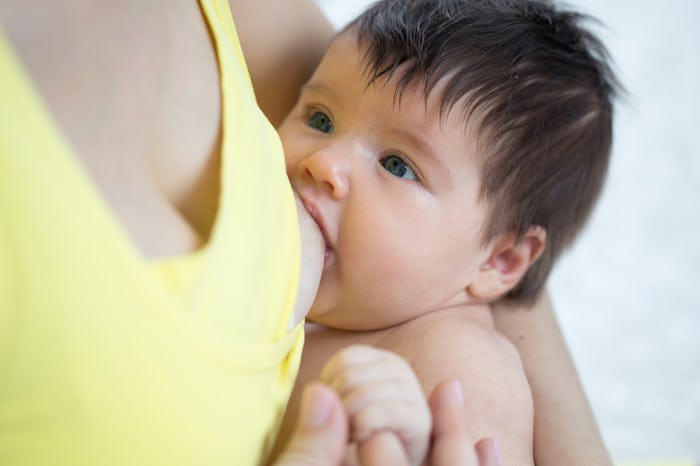Life
Here's How Your Baby Knows How To Breastfeed & It's Mind-Blowing
Throughout all the anticipation, preparation, and difficulties of having a newborn, one thing that remains beautifully astonishing is a baby's instinctual knowledge. As a small, truly dependent being, babies generally still know how to breastfeed from the moment they latch onto their mom's breast. And although it takes some time to get in a good groove for both mom and baby, it's amazing and baffling how the instinct kicks in. If you're wondering how it works, here's how your baby knows how to breastfeed. It's pretty amazing, actually.
From day one, your baby knows what to do when it's time to breastfeed because they're "born with a set of reflexes that are sometimes referred to as primitive reflexes," explains international board certified lactation consultant (IBCLC) Danielle Downs Spradlin of Oasis Lactation Services. As an example, a reflex you're probably familiar with is the knee-jerk reflex that occurs when your doctor takes the rubber hammer to your knee cap. Spradlin says that much like you're compelled to act out that response without thought, babies' natural reflex is to "suck, root, gape (open the mouth), and knead the breast to extract more milk."
Spradlin goes on to share that much like the knee-jerk reflex can be more prominent if your leg is in a certain position, like hanging instead of stiff and straight, you can also heighten or dampen your baby's reflexes taking advantage of certain breastfeeding positions with your baby, too. "For babies, the feeding reflexes are most active when the baby is in a tummy down (prone) position," or "tummy to tummy with mummy." Additionally, the cradle or football positions can actually dampen a baby's breastfeeding reflexes. So if you find you're having difficulty, it's a good idea to take that into account.
Yes, apparently the tummy to tummy position is most ideal for baby's breastfeeding instinct, and Breastfeeding Today offered a great explanation of why. They shared that when the baby latches from this position they're coming down on the nipple from above. This helps them get a solid, deeper latch, guiding the nipple well into the back of the mouth. In other positions, baby is trying to latch up on the nipple, which makes it more likely for them to just latch to the nipple and not the breast. Another reasons it's a great idea to try this approach if you're having latching difficulties.
With this instinct, what's truly amazing to me personally is that baby's breastfeeding instinct is so strong in babies that oftentimes they will actually do something called a breast crawl up to their mothers breast if placed tummy down on their mom after birth. This ability is "triggered by body position (tummy down), skin to skin contact, and smell," according to Spradlin. And these reflexes remain intact for several months after birth.
Although the breastfeeding instinct is perhaps the first and strongest instinct a baby is born with, it does end up fading after a few months. By then, breastfeeding is generally second nature to your child in the position that they're used to. At this time babies begin to focus on developmental milestones, and according to Spradlin, reflexes shift to postural with appropriate play and tummy time.
From the beginning, baby's instincts to survive and breastfeed are pretty powerful and amazing. So if you're worried about how the breastfeeding journey will begin know that it is a natural part of a baby's journey that they're often prepared to begin. Now this doesn't mean it's not going to be challenging at times – breastfeeding isn't always easy. But if it's the journey you want to take, it's well worth it.
Check out Romper's new video series, Romper's Doula Diaries:
Watch full episodes of Romper's Doula Diaries on Facebook Watch.
